Since the publication of my last article in the Zephyr two months ago, the water level at Lake Powell has dropped another two feet. That’s actually less than the typical declines in the fall but the lake has now dropped to a level not seen since 1969 when it was still filling. In an attempt to slow the decline of water in Lake Powell, the U.S. Bureau of Reclamation, which operates Powell’s Glen Canyon Dam and other dams in the Colorado River basin, has been releasing water from upstream dams. The Bureau has also been helped by some early season snowfall in the Rockies which has been melting because of recent Indian summer weather.
The declines in reservoirs which feed Lake Powell are most dramatically seen in Colorado’s largest lake, Blue Mesa Reservoir in the southwestern part of the state (the Blue Mesa Dam was completed in 1966). From June 21 to October 31, 2021, the level of Blue Mesa dropped a whopping 35 feet. The decline can be attributed to both the dry summer and releases from the Blue Mesa dam (from August through October) to slow the decline of Lake Powell. My Denver neighbor, Fil Sapienza, who has a Flickr site with terrific travel and nature photos (https://www.flickr.com/photos/193390301@N07/) has taken photos from the same spot on the south shore of Blue Mesa (a pull-off on Colorado Highway 149) which illustrate the dramatic declines in the reservoir over the past ten years.
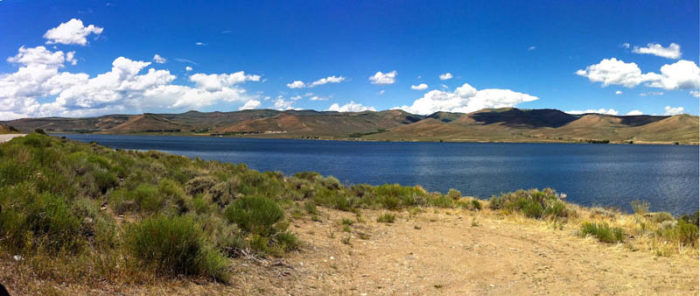
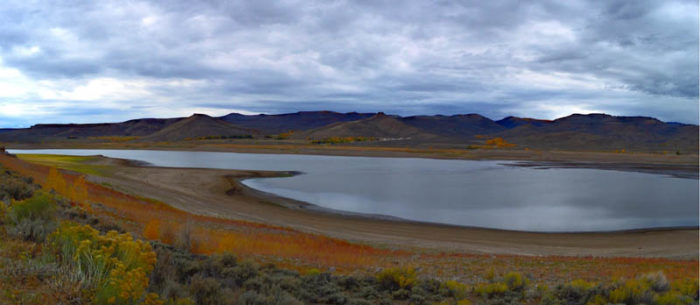
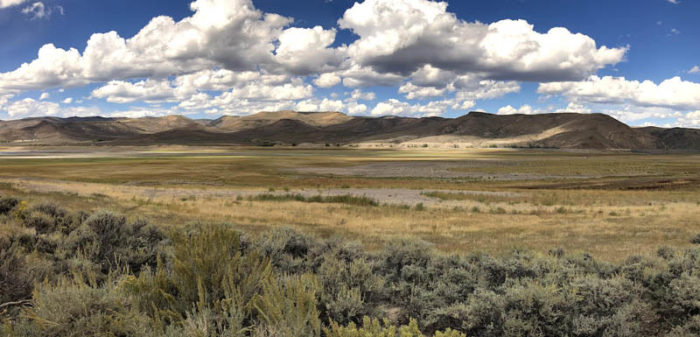
The Bureau of Reclamation’s desperate shell game of robbing “Peter” (the upstream reservoirs) to pay Powell is at best a temporary measure assuming the 20-year Western drought is the new normal. According to Becki Bryant, the Bureau’s Public Affairs Officer in Salt Lake City, these supplemental releases from the Flaming Gorge and Blue Mesa reservoirs ended in October and those from the Navajo Reservoir will end in December. In the meantime, my reading of the daily rises and falls of Powell and the other reservoirs indicate that the Bureau is also tweaking water levels in reservoirs further down the Colorado – Mead near Las Vegas; Mohave – near Laughlin, Nevada; and Havasu near Lake Havasu City, Arizona. The Bureau finds itself caught up in a web of competing interests including the seven states in the Colorado River Basin, Native American tribes, cities, special interest groups, and the general public. According to Ms. Bryant, “protecting the elevations of Lake Mead and Lake Powell remains a top priority” but she avoided direct answers to my specific questions such as, “With both Powell and Mead at record lows, why not release less water from them and let water levels in [downstream] lakes Mohave and Havasu decline?”
In the meantime, the Colorado River shell game of dam releases and non-releases offers a very short-term delay in the coming disaster for hydroelectric power generation, agricultural irrigation, potable water for Western cities, and water recreation.
With regard to water recreation, my partner, Judy, and I visited the deserted Iola Boat Ramp on the southern shore of Blue Mesa Reservoir on September 29 of this year. Here’s what we found there:
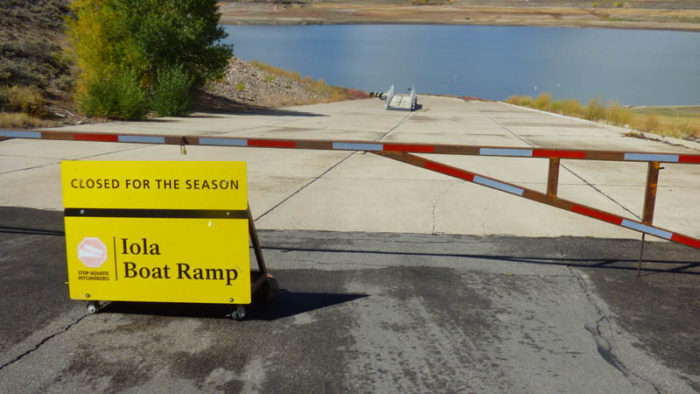
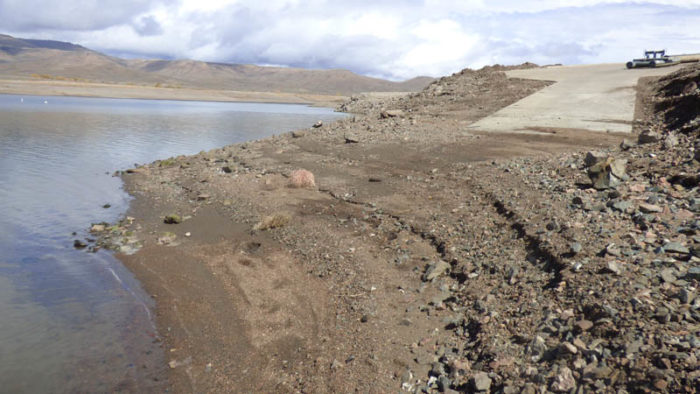
Not only was the Iola ramp “closed for the season” but by early October all boat ramps at Blue Mesa were closed. Unless the mountains receive good snowfall this winter, boaters can expect an even shorter season in 2022.

Here is an easterly view which Judy shot from U.S. Highway 50 of the north side of Blue Mesa reservoir. Water in this inlet used to reach to nearly where she was standing.
On September 30, Judy and I drove to the Taylor Park Reservoir on the Taylor River which flows southwesterly to the Gunnison River which, in turn, flows to the Blue Mesa Reservoir. Thus, releases from this reservoir wind up in Blue Mesa.

Flow in the Taylor River below the dam seemed reasonably good (photo above). However, the water level of the Taylor Park Reservoir was considerably below normal as shown by the extensive mudflats in the photo below. What’s left of the reservoir is barely visible in the distance.
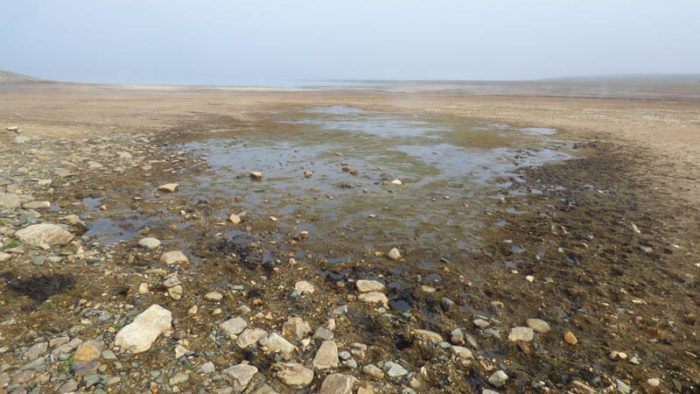
Taylor Park Dam was completed in 1937 to provide irrigation water for farmers and ranchers in the Uncompahgre valley 100 miles to the west. It lies at 9300 feet above sea level and about 3000 feet below the Continental Divide a few miles to the east. It is one of dozens of small dams in the Rockies with associated reservoirs which rise and fall depending on the annual benevolence of the snow gods. Lately, these gods seem to have been enjoying a long nap. Will they awaken this year to bless the West? Stay tuned!
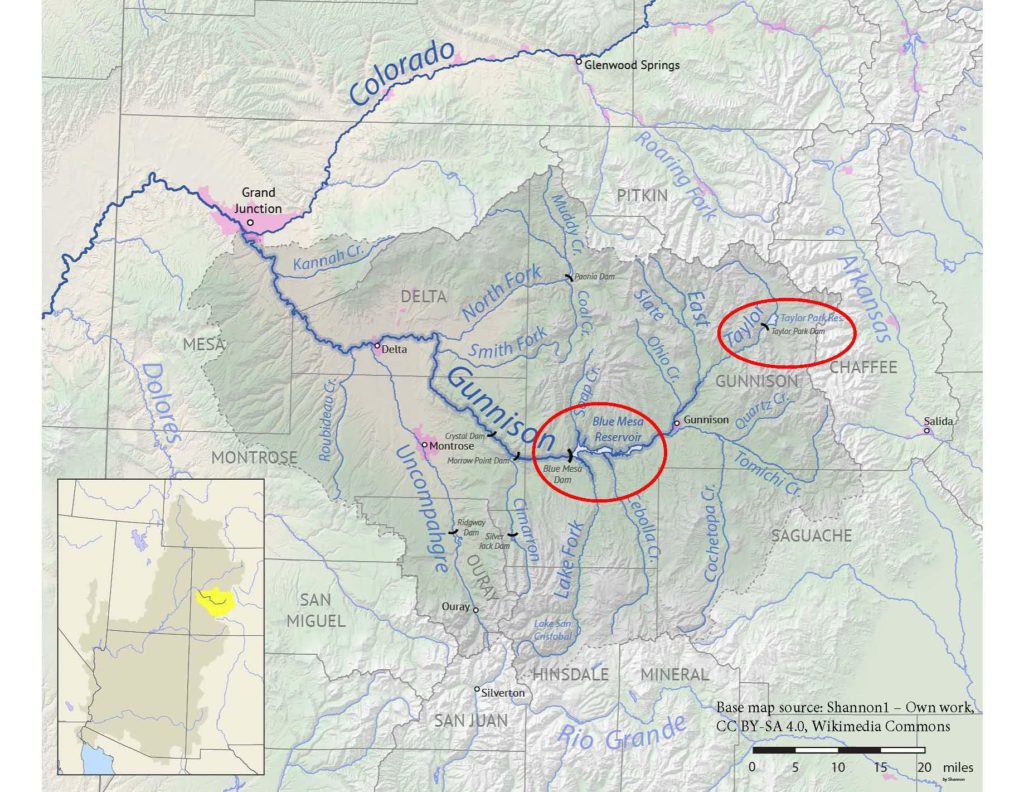
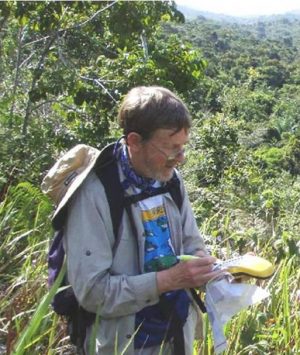
Will Mahoney is a senior environmental scientist with degrees in geography, geology, and environmental technology. He has worked on environmental impact assessments, audits, and inspection programs for energy projects. Will has also done environmentally-related volunteer work in West Africa (as a Peace Corp volunteer), Latin America, Arctic Canada, and the western U.S. Recently, he has been conducting water resources and soil erosion studies for the Southern Plains Land Trust in southeastern Colorado. Will and his partner, Judy Greenfield (an art conservator), have been hiking in southern Utah for the past 27 years. They live in Denver.








Another great article by Mr. Mahoney. Please keep them coming. Is there any way you could make him an actual full-time reporter? I’d love to read additional things that interest him (and us).
And another Bruce seconds all that! Maybe Will has some professional thoughts about the need for, or not, Denver Water’s Gross Reservoir expansion?
Shocking photos, and badly needed. It would be great if your terrific reporting could go out to a broader audience.
Another graphic and informative illustration of the dire situation we’re facing.
Another great article from Will Mahoney! The pictures taken were also fabulous and really
hit home regarding the urgent nature of this situation. Keep ’em coming….so appreciated!
Thanks once more for your informative..worth a thousand words…photo journalistic offerings. We Californians have been seeing our reservoirs shrivel up, too. A wake up call to long term planners everywhere.
Thanks for the Info Will, seems a world trend. Here in Uruguay in the “mountains” the water table is dropping in the valleys, river flows down and wetlands drying up just a few days after a 4.3 inch rain. Normally they stay wet all the time except a month or two in exceptionally dry years. Much aquatic breeding habitat being lost. What impact do the reservoirs themselves have on the Gunnison river ?
Great article from Will! His article should be front page news everywhere in the west, as this is the same story, just a different location. Will we wake up too late? I look forward to Will’s next article….David
Great article! Agreed, the Snow gods are having a long nap! Observing and reporting on the situation is a good beginning, so thank you Will for shining a light on this catastrophe. Perhaps it is the people of the planet who need to awaken from their slumber and realise that nature is not our servant, and that we need to reassess our expectations and plan accordingly.
This situation is really, really serious, and only getting worse. We have got to start publicizing how destructive it is for our human population to keep growing. We must reduce the birth rate as Mother Nature is making clear.
Well written/documented and frightening!
We are all better-off to learn about our earth from writers/photojournalist like Will and his partner, Judy.
Please continue this necessary work.
Yikes! Hard to imagine what will happen in the next twenty years. This whole series of articles are so easy to understand, so undeniable, it’s all out there in the open, Lordy the LA Times needs to pick this up!